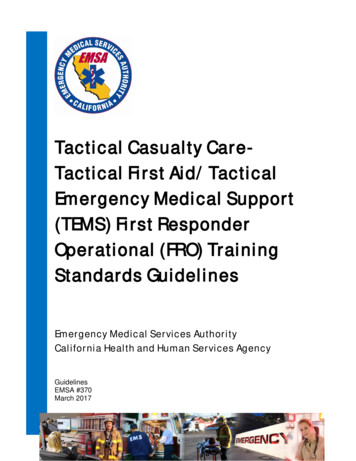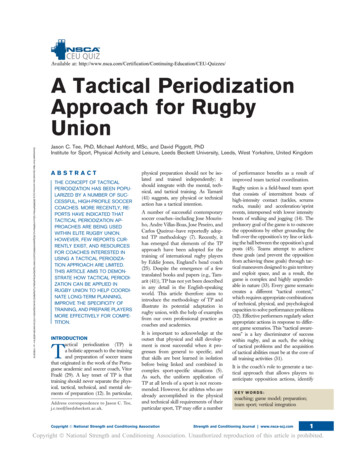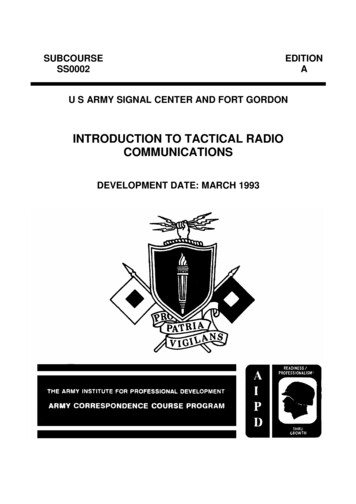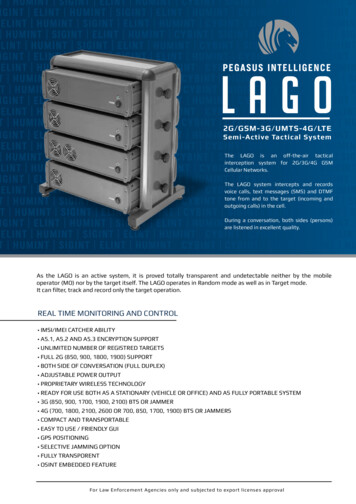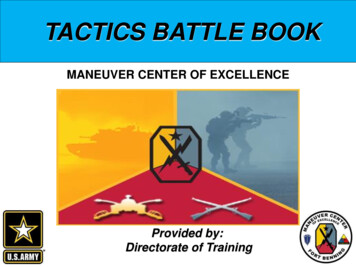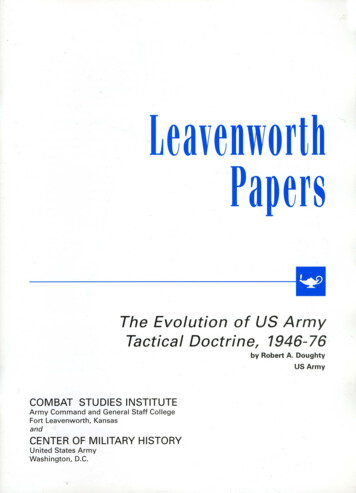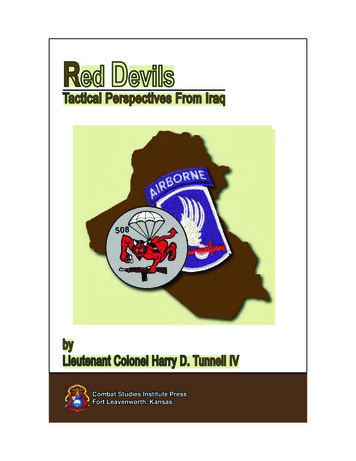
Transcription
Re DevilsedTactical Perspectives From IraqbyLieutenant Colonel Harry D. Tunnell IVCombat Studies Institute PressFort Leavenworth, Kansas
Red DevilsTactical Perspectives From IraqbyLieutenant Colonel Harry D. Tunnell IVCombat Studies Institute PressFort Leavenworth, Kansas
Library of Congress Cataloging-in-Publication DataTunnell, Harry D. (Harry Daniel), 1961Red Devils : tactical perspectives from Iraq / by Lieutenant ColonelHarry D. Tunnell IV.p. cm.1. Iraq War, 2003- 2. United States. Army. Parachute Infantry Regiment, 508th. 3. Airborne operations (Military science) 4. United States.Army--Parachute troops. I. Title.DS79.76.T865 2006956.7044’342--dc222006014481CSI Press publications cover a variety of military history topics. The views expressed in this CSI Press publication are those of the author and not necessarilythose of the Department of the Army or the Department of Defense.A full list of CSI Press publications, many of them available for downloading,can be found at p.
In memory ofFirst Lieutenant David BernsteinPrivate First Class John HartSpecialist Justin Hebert.
ForewordLTC Harry Tunnell’s Red Devils is the history of one Soldier’s and oneunit’s experience in Operation Iraqi Freedom. War must be studied froma variety of perspectives if one hopes to understand it and profit from thatunderstanding. Like studies of grand strategy and operational histories,personal accounts of war are a critical aspect of understanding that immensely complex phenomenon.Using a journal which he kept during the war, then reflecting on his experiences while recovering from the wounds he suffered and while at studentat the National War College, LTC Tunnell tells the story of the 1st Battalion,508th Parachute Infantry Regiment in Northern Iraq. The story of the RedDevils covers that crucial period of time from early 2003 when the Armyprepared for war, through the end of so called ‘major combat operations,’and into the start of the insurgency and counterinsurgency which goes onto this day. This is not a comprehensive, polished historical analysis, but afirst hand account of Operation Iraqi Freedom’s earliest period.Red Devils represents one man’s attempt to make sense of his and hisunit’s experiences in Iraq. It represents only a small part of the history ofmany units and individuals which have taken part in, and continue to takepart in, the defining military campaign of our time. We hope this study willbe useful as readers attempt understand that complex campaign. CSI—ThePast is Prologue.Timothy R. ReeseColonel, ArmorDirector, Combat Studies Institute
ContentsPreface.ixIntroduction. 1Chapters1. Preparation and Training in Europe .32. A Summary of Battalion Combat Operations Doctrine .73. Jumping In and Getting Started.154. In and Around Kirkuk . 195. Operating in AO WEST . 276. The Last Area of Operation . 417. Epilogue. 45AppendixA. Some Final Impressions About Iraq . 47vii
PrefaceInitial US Central Command planning for operations in Iraq commencedin November 2001 with the organization of the Combined Forces LandComponent Command (CFLCC), from an augmented Third Army headquarters. The CFLCC staff planned many contingencies for major combatoperations in Iraq, with most conceptually relying on a main attack fromthe south out of Kuwait to Baghdad and Tikrit, and a secondary attack intonorthern Iraq out of Turkey to advance on Tikrit and Baghdad from thatdirection.By early 2003, operations in northern Iraq were envisioned to be a combination of special operations forces (SOF) elements, Kurdish forces, andconventional troops. The SOF units, under the control of Joint SpecialOperations Task Force North (JSOTF-N), would work with the Kurds(which directly controlled a large area of northeastern Iraq) in the extremenorthern areas of Iraqi territory. The large ground force, consisting of the4th Infantry Division (Mechanized) with the 173d Airborne Brigade attached, would deploy out of adjacent Turkey (in the US European Command area of responsibility) and advance towards central Iraq. This effortwould provide a northern front while the main CFLCC effort would moveon Baghdad from the south.Unfortunately negotiations with Turkey failed to reach an agreement onthe landing and passage of American land forces through that country andinto Iraq. However, the Turks did agree to allow US aircraft to use Turkishairspace. Accordingly, US forces deployed into northern Iraq would haveto be delivered by air. At this point, the 4th Infantry Division was out ofthe picture and JSOTF-N was given responsibility for all operations innorthern Iraq. The 173d Airborne Brigade was now attached to JSOTF-Nas the conventional force.The 173d, composed of two airborne infantry battalions and associatedartillery, reconnaissance, and support elements was essentially given themission originally assigned to the 4th Infantry Division, that of opening aconventional northern front. For this mission, the brigade’s two infantrybattalions were augmented with an armored battalion task force. The 173dwould commence operations by establishing an airhead at Bashur airfield,located northeast of Irbil within the Kurdish Autonomous Region. Onceix
the brigade was in place it would initially operate in support of SOF andKurdish units against the Iraq army forces arrayed along the line (GreenLine) demarking the border between the Kurdish controlled area and thatcontrolled by Saddam Hussein’s Ba’athist regime.Accordingly, on 26 March 2003, the 173d Airborne Brigade began moving by C-17 cargo aircraft from its home station area in northern Italy toIraq and parachuted the bulk of its two infantry battalions onto Bashur airfield. Within six hours, the airfield was ready for airlanding operations andwithin four days the entire brigade was in Iraq. Following establishment ofthe airhead, the paratroopers then conducted a series of operations againstvarious Iraqi army units along the Green Line designed to fix the enemyforces in place so they could not be used in the Baghdad or Tikrit areasto the south. In early April 2003, JSOTF-N and Kurdish forces advancedsouth across the Green Line and liberated Kirkuk on the 10th.In mid-April the 4th Infantry Division arrived in the Tikrit area fromKuwait and assumed responsibility for a large sector of north-central Iraq.The 173d Airborne Brigade was then attached to the 4th Infantry Divisionfor the rest of its time in Iraq which extended to February 2004. Duringthat time, the brigade was primarily responsible for security and counterinsurgency operations around Kirkuk. In February 2004 the 2d Brigade,25th Infantry Division replaced the 173d Airborne Brigade in Kirkuk. The“Sky Soldiers” returned to their home stations in Italy.x
IntroductionThis essay describes the operations of a US Army infantry battalion as itprepared for combat at its home base in Europe and fought in northern Iraqduring Operation IRAQI FREEDOM. The actions described were carriedout by the 1st Battalion (Airborne), 508th Infantry, a subordinate unit ofthe 173d Airborne Brigade stationed in Vicenza, Italy. Both organizationswere part of the US Army Southern European Task Force (Airborne),known as SETAF, and also headquartered in Vicenza, Italy. These unitswere normally responsible to the Commander US Army Europe for training and tasking, and they provided the Commander US European Command (USEUCOM) with a rapid reaction capability throughout Europe,most of Africa, and parts of the Middle East.The 1st Battalion (Airborne), 508th Infantry is more often than not referred to by its World War II regimental nickname—the “Red Devils.” Inthe fall of 2002, the Red Devil mission was to alert, marshal, and deploywithin 24 hours of notification by air, ground, rail, or sea transportation toconduct forcible entry, ground combat, or stability and support operationsto demonstrate US resolve, or respond within 24 hours to crisis as directedby USEUCOM. The battalion would eventually have the opportunity tocarry out nearly every task in its mission statement—although it wouldperform them far outside of its traditional area of employment.1
Chapter 1Preparation and Training in EuropeWith most of Southwest Asia outside the USECOM area of responsibility, there was not a systematic brigade effort to prepare for operations inIraq. Most of the time battalion commanders determined training priorities and established training goals as they deemed fit. However, during thesummer of 2002, even though routine training focused on a USEUCOMregional employment, the Red Devils began to deliberately prepare forwhat was thought to be an eventual deployment to fight in Iraq.The battalion conducted several training periods for non-commissionedofficers (NCOs) and officers to establish a base line of knowledge amongleaders. The training focused on direct combat, or preparing for deployment. The first leader-training period was conducted during the summer of2002 and was a Video Teleconference (VTC) between Italy and Fort Drum,New York with the 1st Battalion, 87th Infantry that had recently returnedfrom Afghanistan. Red Devil leaders discussed with Lieutenant ColonelPaul LaCamera and several of his NCOs and officers the important lessonsthey learned during their battalion’s combat tour in Afghanistan.Additional leader training included topics on how to organize for andconduct various forms of movement to contact, how to establish trafficcontrol points (TCPs) and inspect vehicles during combat operations, andhow to prepare financially for a long deployment. The battalion also conducted a leader-training period specifically about how to operate in northern Iraq. The brigade’s Deputy Commander, Lieutenant Colonel Sean Callahan, had served as a company commander in northern Iraq after the GulfWar, and he gave an outstanding presentation about infantry operationsin the region. This presentation was especially relevant because it highlighted several problems that his unit had operating in the area such asmaintaining Frequency Modulation (FM) radio communication over longdistances.In addition to routine infantry training such as live-fire exercises, deployments to Grafenwoher Training Area in Germany, and maneuver trainingand evaluation at the Army’s Combat Training Center in Hohenfels, Germany, there were real-world tactical events that helped prepare the battalion for combat. The first such requirement was an operational rehearsal of3
a battalion (-) reinforcement of KFOR, the long-established internationalmilitary mission in Kosovo.On 11 July 2002 the Red Devils parachuted onto a Drop Zone (DZ) nearVitina, Kosovo and immediately executed an air assault by helicopterfrom the vicinity of the DZ into the battalion’s assigned patrol area. During the employment in Kosovo the battalion practiced several skills thatwould prove to be useful in Iraq such as assembling on an unfamiliar DZ,developing control measures to decrease the potential for fratricide, andstanding operating procedures for parachuting with live ammunition andbody armor.While conducting tactical operations in Kosovo’s low threat environmentthe battalion gained experience planning and executing a variety of missions such as cordon and search operations, small unit patrols, and reliefsin place with other units. These procedures were refined during trainingat Grafenwoher and Hohenfels, and further modified during combat inIraq. Between periods of collective training at Grafenwoher and battalionevaluations at Hohenfels a regional crisis interrupted routine training. Thebattalion was alerted, marshaled, and prepared for a real-world mission inUSEUCOM’s area of responsibility. Although the battalion did not deploy,the detailed planning and rehearsals for an airborne assault and follow-onoperations focused soldiers on the potential for combat. This helped torefine further—and in some cases validate—procedures learned earlier.The collective training in Germany and the deployment to Kosovo wereplanned and coordinated by the SETAF headquarters and the 173d Airborne Brigade headquarters. All of these events were superb in conceptand execution, and were important milestones that helped prepare the battalion for its eventual employment in northern Iraq.During the late fall and winter of 2002 it became obvious that the potential for war to spread to Iraq was increasing. Throughout this periodthe brigade focused on deployment readiness by organizing and marshaling equipment in anticipation of deploying outside of USEUCOM’s areaof responsibility. The battalion, meanwhile, focused its efforts on smallunit tactical training and integrating new personnel into the organization.The Red Devils conducted an internal Emergency Deployment ReadinessExercise (EDRE), 2-3 December 2002, to inspect alert and readiness procedures, as well as vehicle and equipment preparedness. The exercise culminated with a tactical phase that tested airborne procedures and includeda Command Field Exercise night parachute assault.4
Additional training included live-fire exercises at local training areasand on the installation. SETAF had an excellent on-base facility whichallowed small units to conduct live-fire training with modified weapons.Each company conducted squad live-fire training at the facility and twoof the three rifle companies were able to perform platoon live-fire training. Platoon exercises had to be modified because the building could notaccommodate a full-size platoon. Even though a traditional full-force livefire could not be conducted this training was critical because the trainingaudience was platoon leaders and platoon sergeants and there were a fewcases in which a platoon recently received a leader who had never led hismen during any sort of maneuver training.The battalion also conducted several “virtual” events to rehearse anticipated missions. There was an outstanding computer facility for conducting a variety of simulation-based training on the installation at Vicenza.Before the battalion’s initial objective in Iraq was determined, the unitsimply selected an airfield in Europe and on 5 February 2003 conducted acomputer simulation of a battalion night parachute assault to seize the airfield. This one-day exercise and after action review allowed the battalion’sleaders to train on a variety of procedures, and make sure that everyoneknew and understood the standing operating procedures likely to be usedduring a real mission. The battalion used the computer facility twice more(during March 2003), once after receiving notification of its objective inIraq, and later after leaders had completed their planning for the parachuteassault to secure Bashur airfield in northern Iraq. These events were notonly rehearsals, but also allowed subordinate commanders to present theirconcept of how they would accomplish their tactical mission to the battalion commander.5
Chapter 2A Summary of Battalion Combat OperationsThe initial mission of the 173d Airborne Brigade was to secure an airfield in northern Iraq to establish an airhead and prepare for follow-onforces. The brigade’s task organization for the parachute assault includedelements from: Headquarters and Headquarters Company 173d AirborneBrigade; 1st Battalion (Airborne), 508th Infantry; 2d Battalion (Airborne),503d Infantry; 74th Infantry Detachment; Battery D, 319th Airborne FieldArtillery Regiment; 173d Support Company; 501st Support Company;250th Medical Detachment; Detachment, 2d Special Forces Battalion,10th Special Forces Group, 1st Special Forces; 4th Air Support OperationsSquadron (USAF); and the 86th Contingency Response Group (USAF).1While employed in Iraq, the brigade’s task organization would change asunits were attached to, detached from, or placed under the operational control of the 173d Airborne Brigade. These adjustments were usually basedon the tactical situation, or the arrival of new units into the Iraq Theater ofOperations (ITO).The 62nd Airlift Wing from McChord Air Force Base, Washington performed the airlift which began with a personnel and heavy equipmentairdrop on 26 March, 2003 and concluded with air land missions the following five nights. Seventeen C-17 Globemaster III aircraft conducted62 missions to deploy 2,175 personnel, 3,060 short tons of cargo, and408 vehicles.2 In addition to getting the remaining organic elements ofthe brigade into Iraq during these difficult night landings, the 62nd AirliftWing’s operations included an impressive deployment to the brigade of itsattached heavy task force centered on the 1st Battalion, 63d Armor Regiment (known as Task Force 1-63) with its Abrams Tanks, Bradley FightingVehicles, and other combat vehicles and equipment.The 1st Battalion (Airborne), 508th Infantry conducted its final briefingsand preparation for combat at Aviano Air Base in Italy near the end ofMarch 2003. More than 400 Red Devil paratroopers, along with the rest ofthe assault echelon of the 173d Airborne Brigade, cross-loaded equipmentand personnel into the 62nd Airlift Wing’s C-17 Globemaster III airplanesand departed for the ITO. After the battalion parachuted as part of the brigade into northern Iraq and helped secure an airfield for follow-on forces,it began a series of operations that took it south to perform independentcombat operations in the vicinity of Irbil in early April 2003.7
After fighting near Irbil the battalion moved as part of the brigade farther south to Kirkuk and helped secure the city. The battalion conducted avariety of infantry missions in and around the city. By July 2003, the battalion was conducting counterinsurgency operations to the west of Kirkukin an area of operation (AO) known as “AO WEST.” This area was approximately 100 kilometers from the brigade’s main operating facility inKirkuk. The battalion was withdrawn from AO WEST in September 2003and relieved another battalion-sized task force from the brigade in an areacalled “AO SOUTH.” This area was generally parallel to a major northwest-southeast running highway in At’ Tamim province.The battalion implemented a variety of sustainment and force protectionmeasures to ensure success in combat. Red Devils operated out of numerous improved and unimproved locations but the battalion Field Trains continuously operated out of the brigade’s main facility at the Kirkuk air base.Each company also maintained its company trains and a tent area at thebase to store personal baggage and extra equipment. These areas offereda secure area where companies could rotate soldiers for rest and refit, andmore advanced medical care. Since the battalion occasionally operatedout of the air base, the battalion Tactical Operations Center (TOC) alwaysmaintained some type of headquarters on the base, which was used as thebattalion’s primary command post (CP) whenever the Red Devils operated in and around Kirkuk. This area was also used as a storage, rest, andrefit area for battalion CP personnel anytime the Red Devils operated inforward areas.Companies established patrol bases whenever operating away from theair base. These patrol bases were generally located in populated areas andhoused in permanent structures such as houses or walled compounds. Onlyoccasionally would a company occupy an unimproved area as a patrolbase, and then only for short periods. At a patrol base fields of fire werecleared, the surrounding area was routinely patrolled, and the buildingswere guarded and sandbagged. These small outposts were changed frequently, every few weeks, either as a force protection measure or becausethe battalion was employed elsewhere.The battalion headquarters established an Operational Support Base(OSB) whenever the bulk of the battalion was employed away fromKirkuk. An OSB usually consisted of the battalion CP, the battalion scoutplatoon, the battalion mortar platoon, and a support element that variedin size based upon the mission and frequency of resupply. The OSB was8
very mobile and because it was smaller with less defensive capability thanan average rifle company it relied on an integrated defensive plan amongthe various headquarters elements. Patrol bases and an OSB could be defended by relatively small groups for short periods when a company, or thebattalion, went on a mission. Furthermore, since company and battaliontrains always remained on the air base, forward-positioned patrol basesand OSBs could be abandoned quickly if the battalion was ordered, onshort notice, to move elsewhere.Other areas of concern regarding force protection included measures toprotect the health of the force, and conducting training that integrated replacements and updated combat tactics, techniques, and procedures. Ingeneral, soldiers were ordered to limit the amount and type of local foodseaten. Battalion medical personnel also conducted frequent preventativehealth inspections of the battalion area. Fruits with non-edible skins suchas watermelon were sometimes purchased on the economy and, if personnel did eat locally prepared food, they were warned to stay away from consuming uncooked foods, fruits with edible skin, seafood, and water fromunapproved sources. Watching out for the types of local foods consumed,along with frequent inspection of the battalion’s food preparation areas(they were closed and cleaned if found unacceptable), and unit latrine areas—which required frequent cleaning and the use of fly bait and otherinsecticides—helped curb potential outbreaks of illness in the battalion.Battalion units frequently conducted live-fire training while deployed.Squad leaders were required to routinely re-certify their soldiers on weapons handling procedures and individual movement techniques throughoutthe deployment; this was an important component of the battalion’s riskmanagement strategy to reduce negligent weapon discharges before livefire training and during combat operations. The battalion established firingranges in nearly every area it was deployed. Company commanders hadthe authority to establish static ranges as needed to test fire weapons orconduct other types of non-maneuver weapons firing.Company commanders also developed training plans for team, squad, orconvoy maneuver live-fire exercises. The battalion commander certifiedmaneuver ranges, and authorized any waivers necessary if a commander’slive-fire plan included unusual procedures learned during combat operations. The battalion tactical command post (TAC), company commanders, battalion scout platoon, and company and battalion mortars conducteda battalion live-fire Fire Coordination Exercise with artillery and attack9
aviation (AH-64 Apache Longbow helicopters) to improve understandingof the aircraft’s capability throughout the battalion, and to learn how tointegrate attack aviation into a battalion fire plan.Some of the simple procedures that improved performance during combat were to conduct a leader’s reconnaissance by ground or air wheneverpossible. Communications reconnaissance to determine potential areaswhere FM radio communications might not work, and where a retransmission station (which extends the range of a unit’s tactical FM radio communication network) would facilitate reliable communication were essential.Procedures for having patrols check-in and check-out so the general location of patrols were known in case they needed reinforcement, but wereunable to request it, were implemented. The battalion CP also monitoredroad and trail networks, and restricted movement for a period of time ifa particular road was being used too much and might become an invitingtarget for enemy ambush. Weapons control procedures helped ensure thatfriendly units were not accidentally fired upon, and that a change in statusof whether or not a weapon was supposed to be loaded could be easilydirected.Throughout the deployment the battalion had interpreters attached. Interpreters that deployed with the battalion from Italy came with uniformsand equipment; however, those hired locally did not have special equipment. As the battalion matured in experience, leaders realized that it wasappropriate to provide interpreters who accompanied patrols with bodyarmor and hydration systems such as a Camelbak. The battalion headquarters also requested that interpreters who accompanied patrols receive extrapay as an incentive for performing this hazardous duty. It was importantto keep as many interpreters as possible with platoons and companies because they were essential to helping units interact with the civilian community, local governments, and local law enforcement. Their understanding of Arab and Kurdish customs helped lessen the potential for ethnic andreligious tension resulting from a lack of cultural understanding on thepart of US Forces.LessonsIn this particular part of Iraq, we recognized early on that consolidatingthe companies into a battalion base camp might give the enemy an advantage because large areas are easier to accurately attack with stand-offsystems such as mortars and rockets. Furthermore, since base camps are10
11Red Devil Operations (March – October 2003).
often built outside of civilian populated areas, it is easier for an enemy toconduct reconnaissance on units because there are fewer areas to watch,they can monitor patrols leaving and entering the base, and they can easilydetermine routes being used since roads in and out of bases are limited.The enemy has greater freedom of maneuver whenever large areas arerelinquished to him by a lack of sustained coalition presence. We alsolearned that bases that are separate from population centers might makeit more difficult for walk-in sources to approach coalition forces and provide information. Many potential sources might be hesitant to approachbecause it is so easy for an enemy to observe their entry and exit from thebase.Current rations are designed to support short duration contingency operations; consequently, there are not a wide variety of menus. Because of thepoor ration cycle and repetitive menu choices people would not consumethree meals a day even though they were available. When soldiers do notget the proper caloric intake for the amount of work they perform, or theyeat food purchased locally to get a little variety this can promote an assortment of health problems, and impact readiness. Menu variety should beincreased along with the number of veterinarians and water purificationassets in a brigade. More potable water means that Mobile Kitchen Trailers (MKTs) can be used at forward locations. Veterinarians in brigadesensure that local food stuffs can be inspected and purchased for preparation in MKTs. These steps will increase selection and limit the number ofresupply convoys bringing prepared food to forward locations which willlower the probability of ambush.We eventually realized that properly equipped interpreters increase theeffectiveness of a unit several-fold because they explain local customsand traditions, interpret graffiti, etc. Interpreters also explain the necessityfor combat operations to local communities; highlight why certain peopleare detained; outline house search procedures to the occupants; ask localleaders to accompany searching units and report back to the communitythe professionalism of the unit’s conduct; and request that certain peoplesurrender themselves for questioning. We tried to keep interpreters at platoon level and available to accompany squads on patrol, and made surethat we had enough interpreters on-hand to be incorporated into a unit’s12
rest and rotation plan (five days on and two days off, etc.) without a lossof capability.Before our employment we knew that continuing to train while deployedwould be essential. Units must incorporate new tactics, techniques, andprocedures that are learned as a result of combat operations, and new personnel must be integrated into squads and platoons. Live-fire exerciseswere a critical component of our training program. We kept maneuverlive-fire exercises simple ensuring a unit could accomplish its traininggoals in an austere, dangerous and, at the same time, complex environment. We found that we had to modify normal procedures in order to conduct training safely, and to do so under severe time constraints. Modifications were deliberate and not haphazard; a formal waiver signed bythe battalion commander outlined waived procedures and new measuresimplemented to compensate for the loss of a particular training or safetyprocess. If another unit was live-firing for training, or to synchronize theirweapons systems (attack helicopters, artillery, etc.) we did not waste theopportunity; we combined our training goals with theirs and developed aFire Coordination Exercise.We tried to deploy with many of the necessary materials to conduct training. We also established a standard for range control procedures in thecombat area. We established blocking positions to provide force protectionfor the training unit, and to ensure that civilians did not enter the rangeduring live-fire periods. Units should prepare for this at home station bywriting scenarios that require gate guards and other administrative personnel to act (and be equipped) as if they are performing the same tasks during a combat de
In addition to routine infantry training such as live-fire exercises, deploy - ments to Grafenwoher Training Area in Germany, and maneuver training and evaluation at the Army’s Combat Training Center in Hohenfels, Ger-many, there were real-world tactical
